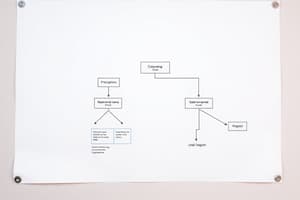Podcast
Questions and Answers
What is the main purpose of a Class diagram in UML?
What is the main purpose of a Class diagram in UML?
- To represent the structure of the system and model concepts in the application domain (correct)
- To represent potential life histories of an object of a class
- To highlight how different parts of the system interact
- To model the functionality of the proposed system as perceived by people or things that interact with the system
What does a State Machine diagram in UML primarily represent?
What does a State Machine diagram in UML primarily represent?
- The functionality of the proposed system as perceived by people or things that interact with the system
- Potential life histories of an object of a class and the transitions triggered by events (correct)
- The structure of the system and model concepts in the application domain
- How different parts of the system interact
What is the primary focus of a Collaboration diagram in UML?
What is the primary focus of a Collaboration diagram in UML?
- Representing potential life histories of an object of a class
- Modeling the functionality of the proposed system as perceived by people or things that interact with the system
- Highlighting how different parts of the system interact (correct)
- Representing the structure of the system and model concepts in the application domain
What is the significance of a Use Case diagram in UML?
What is the significance of a Use Case diagram in UML?
What is the main purpose of an Activity diagram in UML?
What is the main purpose of an Activity diagram in UML?
What is the primary function of a Package diagram in UML?
What is the primary function of a Package diagram in UML?
What does a Sequence diagram in UML primarily show?
What does a Sequence diagram in UML primarily show?
What does a Sequence diagram in UML implicitly show?
What does a Sequence diagram in UML implicitly show?
Flashcards are hidden until you start studying
Study Notes
UML Diagrams
Class Diagram
- The main purpose of a Class diagram is to represent the structure and relationships of classes and objects in a system.
State Machine Diagram
- A State Machine diagram primarily represents the different states of an object and the transitions between those states.
Collaboration Diagram
- The primary focus of a Collaboration diagram is to show the interactions between objects and how they collaborate to achieve a goal.
Use Case Diagram
- The significance of a Use Case diagram is to capture the functional requirements of a system from the user's perspective.
Activity Diagram
- The main purpose of an Activity diagram is to model the flow of activities and actions in a system.
Package Diagram
- The primary function of a Package diagram is to organize and group classes and other elements into packages or namespaces.
Sequence Diagram
- A Sequence diagram primarily shows the interactions between objects over time, including the sequence of messages and events.
- A Sequence diagram implicitly shows the timing and synchronization of these interactions, highlighting the dependencies between objects.
Studying That Suits You
Use AI to generate personalized quizzes and flashcards to suit your learning preferences.



